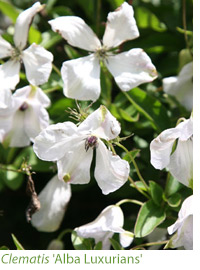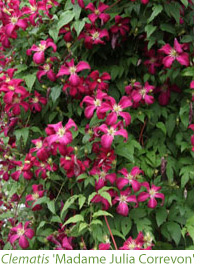Late flowering clematis
August can be a tired old month in the garden, especially in hot dry summers, so it’s important to have some fresh-looking flowers to lift our spirits and climbers can play a huge role at this time of year. They offer flowers at eye height and they can help to soften the boundaries, particularly fences, or you can use them on an arch, or plant up obelisks. They’ll add more colour and all-important vertical accents and many take up little ground space, a big consideration now that many of us have smaller plots.
They say that clematis is the Queen of climbers, and the ones that flower between Midsummer’s Day (June 21st) and the Autumn Equinox (September 21st) are among the most useful to the gardener because they produce an abundance of smaller flowers that mix in well with herbaceous plants. These mainly come in blues, purples, reds and whites and they are the easiest of all to grow.

Many of these are Viticella clematis, which are bred from a Spanish, drought-resistant species so they’re tolerant of poorer soil. There’s no fear of them collapsing with wilt either, which some of the larger flowered clematis are prone to, plus they’re the easiest to prune.
Clematis are pruned according to the 'group' they fall into:-
Group 1 contains clematis that don’t need to be pruned, because this group flower on last year’s wood, mostly producing flowers in winter and spring. They include the alpinas, macropetalas, montanas and the evergreen cirrhosa and armandii groups. If you do need to prune them, to tidy them or restrict them slightly, it must be done immediately after flowering.
Group 2 is a light pruning group, and includes all early, large-flowered forms including the double and semi-doubles. These plants produce their main flush of flowers in May and early June, on stems made in the previous year so pruning is limited to cutting out the dead or weak shoots in February.
Group 3 includes the viticellas, orientalis and texensis are the simplest - just cut them back to new growth in mid-February (clematis enthusiasts often call this the Valentine’s Day Massacre) and they will produce vigorous new growth and flower in the second half of summer. However it’s not a good idea to plant no-prune Group 1 close to cut-back-hard Group 3. The stems will entwine and you won’t know which to leave and which to cut!

The viticella clematis are light scramblers so they can be used in various ways. They could be allowed to cover well-established large shrubs and small trees. They make excellent follow up acts to rambling roses, which flower only once in June. Or you can train them on fences, or up trellises, or on arches.
 Flower shape varies and some have rounded flowers, others form stars and some have asymmetrical flowers, often with green markings. The vigorous Clematis ‘Alba Luxurians’ is one of these irregular, green marked beauties and it has a country charm.
Flower shape varies and some have rounded flowers, others form stars and some have asymmetrical flowers, often with green markings. The vigorous Clematis ‘Alba Luxurians’ is one of these irregular, green marked beauties and it has a country charm.
The strongest varieties come in shades of purple and ‘Étoile Violette’, raised by Morel of France in 1885, is still superb despite its age. It’s usually the first to flower and by July lots of deep purple flowers will appear and each one has a golden boss of stamens. ‘Polish Spirit’, a Polish variety raised in 1984, is often the latest with mainly four-petalled, purple flowers arriving in August. Each petal is lightly barred and the middle has a purple tint. Growing both together should give you flower from July until September.
Not all viticellas have starry flowers though. ‘Perle d’Azur’, another Morel variety named in 1885, has large leaves and larger, rounded mid blue flowers - the colour of a summer sky. This stunning clematis is often grown on an obelisk, but it is harder to establish and may take 3-4 years to really get going. However it is worth the effort, being unique with its large leaves and lovely flowers.

Wine red flowers also feature and ‘Royal Velours’, another old Morel variety, is very distinctive with velvet-textured, full flowers with four petals that overlap slightly. Thickly textured petals are particularly admirable at the bud stage. ‘Niobe’ is similar, but blacker in tone and it’s less vigorous, generally reaching 6 feet or more. 'Warszawska Nike’ has more petals than most, up to 8, overlapping with a bright-yellow centre. The textured rich reddish-purple thick petals make this an eye catching clematis.
 There are two more notable wine-red clematis which are both moderately vigorous and do well in shadier positions. ‘Madame Julia Correvon’, another Morel classic from 1900, has slightly twisted narrow claret-red petals set round a small golden middle. ‘Kermesina’ is still good, although the central boss is almost black, so perhaps not as fresh-looking as ‘Madame Julia Correvon’, but good for moodier colour schemes.
There are two more notable wine-red clematis which are both moderately vigorous and do well in shadier positions. ‘Madame Julia Correvon’, another Morel classic from 1900, has slightly twisted narrow claret-red petals set round a small golden middle. ‘Kermesina’ is still good, although the central boss is almost black, so perhaps not as fresh-looking as ‘Madame Julia Correvon’, but good for moodier colour schemes.
The dark, navy-blue to black clematis work well with the golden-leaved shrubs, and ‘Romantika’ is one of the darkest of all. There are also two historic doubles, believed to be from the 15th or 16th century and their flowers last a very long time. C. viticella 'Flore Pleno' (syn.‘Mary Rose’) is a dusky dark blue and ‘Purpurea Plena Elegans’ has purple-pink flowers. Both could be mistaken for roses at first sight, with their long lasting rosettes.


If you want to go paler there are two with fuller rounded, single flowers. ‘Fond Memories’, not a viticella but a large-flowering late in Group 3, has pink-white satin textured petals edged finely in rose-lavender. These are set round a dark purplish middle. ‘Prince George’ is a very new ruffled single white with more open flowers made from four frilly petals. There are also clematis with tulip pink flowers, with texensis blood, and ‘Princess Kate’ is a white with rose-pink backs to the petals and a dark middle. This rations out its flowers over summer and autumn. The striking pink-red ‘Princess Diana’ bears more flowers over the same long period. Both could be grown on a large obelisk.
If you want something a bit different then the new variety Clematis 'My Angel' is a real head turner. From the tangutica group of clematis the small, burgundy-red nodding flowers, with a burgundy flushed yellow interior, and a striking boss of yellow stamens will smother the plant from midsummer until the autumn when the fluffy seeds heads develop.

If you haven’t got room for a large obelisk there are clematis that are perfect for containers and they include the lime-green and lavender double ‘Crystal Fountain’, or the exquisite Clematis ‘Taiga’ with stunning double blue-purple flowers and greenish white tips. This climber is free flowering, often well into the autumn. Like all doubles they will need a gentle prune, to remove any dead wood, early in the year.
Container-grown clematis need to have cool roots. Place them in a bright spot, but not in a full south-facing position. Use pot feet in winter, to elevate the pot and aid drainage. It will grow up to 2m in the ground, but nearer 1.5m in a pot. You may need a simple tripod to support it.

Always use a soil-based John Innes compost when potting up a container, because loam-based compost holds moisture and nutrients more efficiently than peat or wood-based compost. Apply a general-purpose liquid fertiliser monthly during spring and summer. Replace the top 2.5-5cm layer of compost each spring with fresh potting compost.
The roots of clematis in containers should be protected from freezing in winter and baking in summer. It’s a good idea to shade the pot in summer by placing some more plants on the sunnier side. When winter arrives, move the pot into the lea of the house to prevent cold from frosting the roots, or fleece and bubble wrap your pot. Remove the protection in early spring as it may harbour slugs and prune once the buds begin to break.












